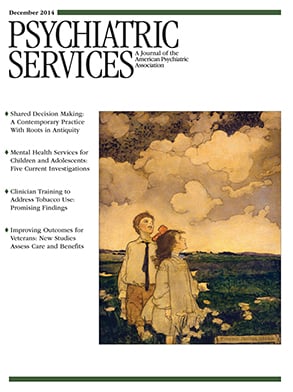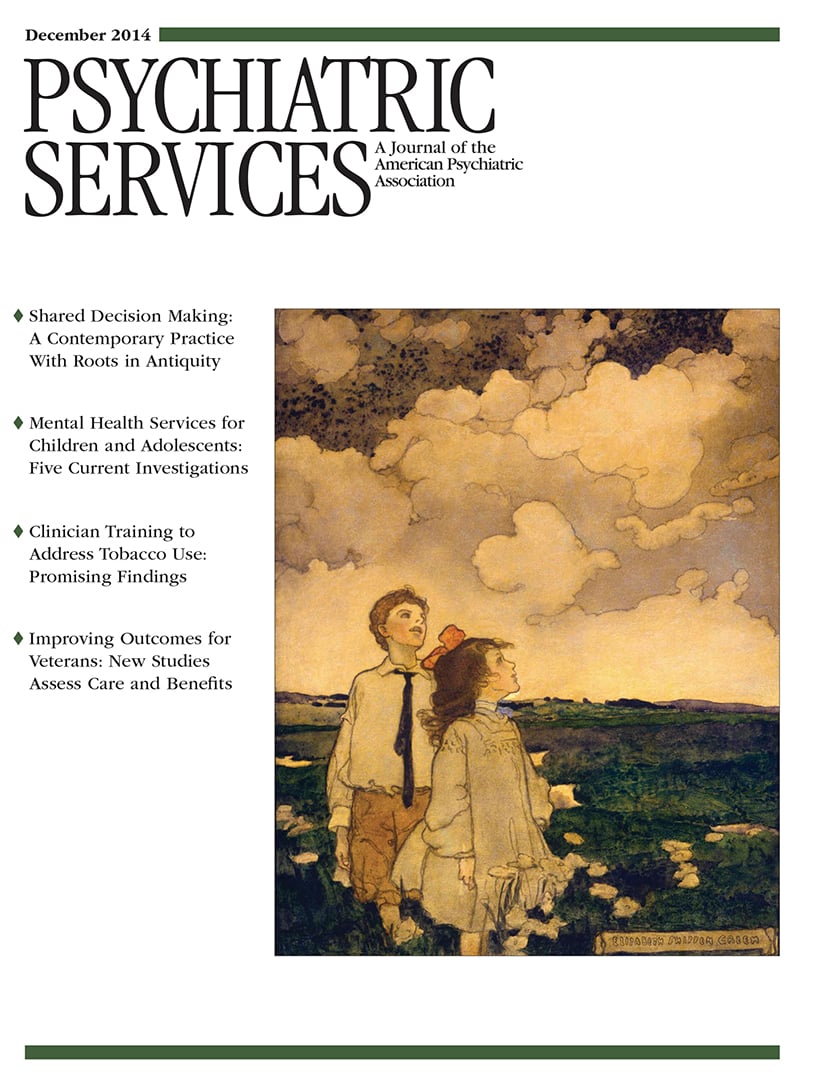Understanding the experience of individuals across stages of schizophrenia is important for development of services to promote recovery. Qualitative research is key to this endeavor. For example, we know from qualitative studies that older adults with schizophrenia describe symptom improvement over time but variable function (
1). Also, social withdrawal is common among older adults with schizophrenia (
1) and among young adults with a first episode of psychosis (
2). Less is known about the putative prodromal stage or clinical-high-risk state for psychosis, characterized by attenuated psychotic symptoms. Qualitative research can help inform service delivery, which is relevant for prevention and recovery among at-risk youths (
3).
Only three small qualitative studies of youths (samples ranging from six to ten participants) at clinically high risk for psychosis have been published (
4–
6). Two involved primarily males, who described isolation and difficulty in social interactions and a reluctance to describe their experiences to others (
4,
5). A third examined pathways to care among mostly girls in high school, noting the importance of family, community, and school (
6). In this study we aimed to characterize more in depth—by using phenomenological qualitative research methods—the subjective experience of at-risk youths by interviewing a relatively large group of 27 ethnically diverse males and females who were participants in a prodromal research program. The interviews focused on changes experienced over time and their impact, what has been helpful or not, and expectations for the future.
Results
There were 27 participants, ages 16 to 27 (mean±SD age=21.4±3.3), including 15 males (mean age=20.5±2.9) and 12 females (mean age=22.6±3.4). Participants were ethnically diverse, with 12 Caucasians, five African Americans, four Asian Americans, and six individuals self-described as “more than one race.” Ten identified as Hispanic. Seven males and nine females were engaged in full-time work or school or a combination thereof. Seven males and two females were unemployed. Psychosis was reported for a first-degree family member by four males and seven females. Of the 27 participants, four (three males and one female) developed nonaffective psychosis within two years after the interview.
Qualitative analysis suggested broad gender differences in emergent themes with some overlap. For males, themes included feeling abnormal or “broken,” a focus on going “crazy,” fantasy and escapism, and alienation and despair, primarily in the context of desiring relationships. For females, themes included psychotic illness among family members, personal trauma, struggle with intimate relationships, and career and personal development.
Five males described feeling “broken” or “abnormal,” variably ascribed to genes or abnormal development or immigration. One male said, “Maybe in my head something did not develop properly or there is something missing. If I had never come to the United States maybe I would not be the same person I am now. I would be more normal.” Another male said, “Things that happen in the brain and things that I experience are probably just in my genetic code. I was born with it.”
Five males used the word “crazy” during their interview, and three others used related slang terms—for example, “If I had to deal with everything I am supposed to deal with, I would go insane.” This fear of going “crazy” was common. One participant said, “The anxiety about being crazy was worse than forgetting a meal.”
Seven males described fantasizing about and desire for escape. One wanted to leave home (because he said that he hated it there) in search of magic and a dream of a utopia where “everyone can accept and just love each other equally.” Another male endorsed “hitchhiking” and “bohemianism.” Another said, “I fantasize about living in worlds with different laws of physics, different cultures, societies, ways of life, everything. What would it be like to live like an animal?” Half of the males described withdrawal, such as spending hours surfing the Web and playing video games instead of going to class, sleeping more, and living like “a hermit.”
Eight males described alienation and despair. One said, “The future feels bleak. I feel pointless right now. I’m getting old. I didn’t finish college. I don’t have a girlfriend, never really had a girlfriend. It feels like a shard of glass in my mind. You know, it irritates. I don’t plan to find the future, because somehow in my mind the future always ends up with me with a big beard, very dirty and homeless.” Another male said, “I want to communicate to other people, but sometimes I feel like I’m just mumbling over some kind of mountain. I’m trying to make myself understood, but they just can’t hear me, no matter how hard they try.” Many described a wish for relationships—for example, “I just want to have a special someone.”
Other themes were evident among females. Seven described psychosis of a family member, usually mothers. All females with a documented family history of psychosis (ascertained in the prodromal research program) brought this up spontaneously.
Eight females spontaneously brought up a history of trauma, including neglect, abuse, parental separation, and witnessing violence. One female said, “I grew up completely neglected and abused. They didn’t explain to me why I was getting hit.” Another described her childhood, “There was one summer we went like entirely without food. We lived in a homeless shelter for a year.”
Seven females described being in an intimate relationship, yet struggling—for example, “relationship troubles.” They described fears of being hurt or abandoned and struggling interpersonally. One explained, “I have a boyfriend, but I am scared of getting close to him to the point where he is going to hurt me or he is going to just disappear somehow or something is going to happen to him where he is not in my life anymore.”
Seven females described motivation and plans for a career, speaking of “academic progression,” “a series of credentials,” and “the analogy of the staircase.” One said, “Most of my life, kind of the goal I have for myself was just being able to be independent in any way, to have a little apartment—it’s kind of like my ultimate goal.” [Further illustrative quotations are listed in an online data supplement to this report.]
Discussion
Emergent themes in these interviews were largely different for males and females. Males described alienation and despair, feeling broken, and a fear of going “crazy.” They desired relationships but were alone instead, escaping into fantasy. They had a vague hopefulness that things might improve in the future but no real plan going forward. By contrast, the females described being in the thick of things, managing relationships and building careers while dealing with the sadness of ill family members and past trauma.
These data are consistent with earlier qualitative studies of males (
4,
5) and females (
6) at clinically high risk of psychosis and with our prior findings that were based on structured interviews in the larger cohort, namely greater severity of negative symptoms among males (
8). The emphasis on career and personal development among females here is consistent with their greater participation in the workforce and in educational programs. Of note, a general pattern of superior functioning among females has been described across early stages of schizophrenia in other clinical-high-risk cohorts (
12,
13) and among patients with a first episode of psychosis (
14).
Our qualitative data complement findings from our prior studies (
8) and breathe life into their numbers. Males experienced negative symptoms and depression as alienation and despair. Attenuated psychotic symptoms for males were interpreted as going “crazy.” The existential pain for them was such that they sought escape, largely into fantasy. This constellation poses a significant challenge for treatment and recovery because it reflects low self-esteem (“broken”) and maladjusted coping (“escape”); however, their desire to have relationships represents a potential base for forming treatment alliances in supportive and behaviorally based therapy. Outreach to males via the Internet may be useful, given their isolation. By contrast, the females in our study were largely pragmatic and future oriented, in the process of building a career, juggling obligations to others, and grappling with the emotional aftermath of trauma. Females might benefit from treatment services with extended hours that accommodate their busy days of work and school and from more trauma-oriented therapy focused on emotion regulation.
Emergent themes in our study echo findings from interviews with older adults with schizophrenia, specifically early exposure to trauma and family mental illness, desire for escape, social isolation in the context of desiring relationships, and finally despair (
1). Whereas older women interviewed in previous studies generally had a sense of resignation (
1), our data suggest hopefulness and energy among younger women at risk.
Participants generally reported finding it useful to talk about their experiences, which is common in qualitative studies across stages of schizophrenia (
1,
2,
4–
6). This is a promising basis for engagement and treatment alliance. “Telling one’s story” can be empowering and can counteract stigma and isolation and promote recovery for individuals with schizophrenia (
15).

